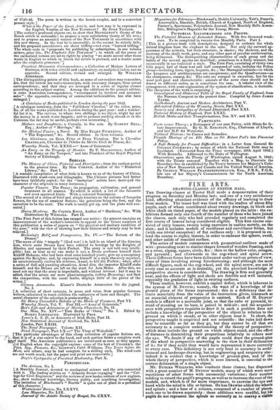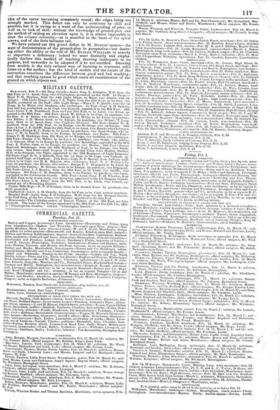FINE ARTS.
DRAWING-CLASSES AT EXETER HALL
TnE Drawing-classes at Exeter Hall made a demonstration of their progress on Saturday and Monday last; and one of a very satisfactory kind, affording abundant evidence of the efficacy of learning to draw from models. The lesser hall was lined with the studies of about fifty pupils, each of whom contributed about twenty drawings, in black and white chalk on tinted paper, of the models placed on the table : the ex- hibitors formed only one-fourth of the number of those who have joined the classes, such only who had attended regularly and completed the first course of lessons being considered eligible. This first course con- slated of sixty lessons, twenty being exercises in outline merely, on the slate ; and it includes models of rectilinear and curvilinear forms, but (with one trivial exception) of fiat surfaces only : it is proposed to ex- tend the course to eighty lessons, in order to embrace the sphere, ovoid, and other solids of rounded surface.
The series of models commences with geometrical outlines made of wire : proceeding next to similar shapes formed of wooden framing, such as a cross, zigzag, square, circle, &c.: then to the hollow cube, octagon, and pyramid ; and afterwards to the cog-wheel and spiral screw. These different forms have been delineated under various points of view, some of them involving strong foreshortening ; and although the most difficult figures, such as the cog-wheel, and the spiral screw, are not in every case so accurate as is desirable, yet the practical knowledge of perspective shown is considerable. The drawing is firm and generally neat, and the effects of light and shade are forcible and well imitated, especially the gradation of light in retiring surfaces.
These studies, however, exhibit a capital defect, which is inherent in the system of M. DUPUIS ; namely, the want of a knowledge of the ground plans of the forms represented : this is a deficiency that de- tracts materially from the value of the instruction given, inasmuch as an essential element of perspective is omitted. Each of M. DUPUIS' models is affixed to a moveable joint, so that the cube or pyramid, in- stead of standing on its base, is poised in mid-air ; and the acquaint- ance with perspective requisite to draw it in such a position does not include a knowledge of the perspective of the object in relation to the ground on which it stands, or to other objects near it. In short, the perspective taught is empirical and not scientific : the rules laid down may be scientific so far as they go, but they cannot be all that are necessary to a complete understanding of the theory of perspective; which must include the ground on which objects stand, and the effect of distance in diminishing their proportions relatively to others near the eye. We doubt if any of the pupils could draw the ground-plan of the wheel in perspective answering to the view in their delineation of it ; for if they could they would have represented it more correctly in every case. This deficiency is not only fatal to accuracy in archi- tectural and landscape-drawing, but in engineering and carpentry also : indeed it is evident that a knowledge of ground-plan, and of the whole theory of perspective, which is soon learned, is essential to the correct delineation of a single object. Mr. BUTLER Wa.masis, who conducts these classes, has dispensed with a great number of M. Durum' models, many of which were mere repetitions of other forms with unessential variations ; their number tending to retard the pupil's progress, as well as to increase the cost of the models, and, which is of far more importance, to exercise the eye and hand while the mind is idle or listless. He has likewise added the wheels and spirals ; and a base of a column, composed of a number of pieces each one to be drawn separately: these additions were needful, but has pupils do not represent the spirals so correctly as to convey a visible idea of the curve traversing completely round ; the edges being too strongly marked. This defect can only be overcome by skill and practice, but it is owing to a want of due understanding of plan, as well as to lack of skill : without the knowledge of ground-plan and the method of raising an elevation upon it, it is almost impcssible to draw the column correctly,—as is manifest in the bases of the spiral screws, and of the little balluster rail.
We have pointed out this grand defect in M. DUPUIS' system—the want of demonstration of the ground-plan in perspective—not doubt- ing either the ability or the will of Mr. BUTLER WILLIAMS to remedy so important a deficiency : indeed we must distinctly and empha- tically declare this method of teaching drawing inadequate to its purpose, and unworthy to be adopted if it be not rectified. Drawing from models is the only rational way of learning to represent solid forms on a flat surface ; but the kind of models and the nature of the instruction constitute the difference between good and bad teaching ; and that teaching cannot be good which omits all consideration of the ground on which objects rest.



























 Previous page
Previous page